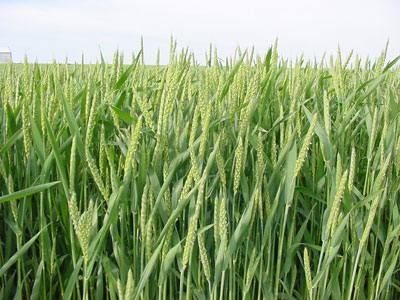
Winter wheat green-up and early growth is progressing nicely in most areas. Management efforts for this crop should be initiated based on growth stage, not calendar. Following are summaries of wheat growth stages for Feekes 2.0 through Feekes 8.0, along with some brief management tips.
Feekes 2.0-3.0 – Tillering and completion of tillering. Tillering begins in the fall but may not be completed until this time. (Wheat in southern areas is mostly well past this growth stage.
[Management Tips]: Tillering of thin wheat stands may be encouraged, at this time, by application of 30-50 pounds of nitrogen, shortly after dormancy break.]
Feekes 4.0-5.0 – Spring green-up. Noticeable erect growth of the wheat takes place at this time. The number of spikelets per wheat head spike are being determined. Any additional tillers forming after this point will not contribute to yield.
[Management Tips]: This is the optimal time to apply topdress nitrogen and most postemergence herbicides, like Harmony SG and Harmony Extra SG. Start scouting for virus diseases and early incidence of fungal diseases at this time.]
Feekes 6.0 – Jointing, First Node Visible - When wheat resumes growth in the spring, one of the first “landmark” stages we look for is Feekes 6.0, development of the first node. This node is close to the crown and can be felt as a hard swelling in the stem. Additional nodes are compressed into node one, and will be pushed higher as stem elongation occurs. Dissection of the stem at this stage reveals a mass of vegetative material above a tiny growing point, which is just above the first node. Behind the first node, between the node and the crown, the stem is hollow in most varieties. [Note: Jointing has been observed in some southern Illinois wheat.]
[Management Tips]:: Growth regulator herbicides should not be applied during or after this growth stage. Liquid nitrogen (UAN, others) application, after rapid growth resumes, may result in burning of leaf tips, particularly when applications are made on cold, windy days. In most cases, the wheat will grow out of the damage with little or no yield reduction. However, some of this burn may be avoided by:
- Applying less than 60 pounds of nitrogen in a single trip.
- Diluting the nitrogen solution 50/50 with water.
- Using streamer nozzles for the application.
- Using flood nozzles that generate coarse droplet size.
- Avoid application on cold, windy days.]
Feekes 7.0 – Second Node Visible – Stem elongation is speeding up by the time the second stem node can be detected. Again, the node can usually be felt as a hard swelling in the stem. Dissection will reveal vegetative material and the growing point above this node, and a hollow area between the second and first nodes.
Feekes 8.0 – Flag Leaf Visible (At least three stem nodes detected) – Flag leaf emergence will not occur until at least three stem nodes can be detected (sometimes four). You can confirm flag leaf emergence by dissecting the plant above the last node. If nothing but the developing wheat head is present (no additional leaves), the last visible leaf is the flag leaf.
[Management Tips]: Harmony Extra SG and Harmony SG application should take place after the two leaf stage, and up to the appearance of the flag leaf. Be particularly careful with tank mixes containing Harmony plus nitrogen solutions, since this can increase activity of the herbicide on the crop. Fungal leaf diseases should be evaluated by this time and fungicide applications made where necessary.]